Location
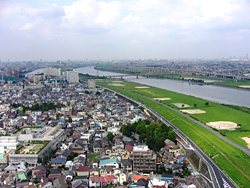 Adachi City is located in the northeastern part of Tokyo’s 23 wards,
and is comprised of two districts: the Senju district, which lies
between the rivers Sumidagawa and Arakawa, and the area north of Arakawa,
which makes up most of Adachi’s geographical area. The Senju area
served as an old post station town along the Nikko Kaido, a historical
highway during the Edo period (1603 - 1867). It is currently a commercial
district centred around Kitasenju station, the city's largest termninal.
Adachi City is located in the northeastern part of Tokyo’s 23 wards,
and is comprised of two districts: the Senju district, which lies
between the rivers Sumidagawa and Arakawa, and the area north of Arakawa,
which makes up most of Adachi’s geographical area. The Senju area
served as an old post station town along the Nikko Kaido, a historical
highway during the Edo period (1603 - 1867). It is currently a commercial
district centred around Kitasenju station, the city's largest termninal.Geographical area
The total area of Adachi is 53.20 ㎢ and amounts to approximately 9% of the geographical area of Tokyo's 23 wards combined. Adachi is third in size after Ota and Setagaya. Adachi is largely flat, with no hills or highlands. The highest point is an artificial bank built along the river Arakawa, which is only about 10m high. The northwestern part of the city is somewhat higher, sloping gently down towards the southeast.Population
The population of Adachi City is 661, 610. (as of April 1, 2009)
There are 72 primary, 37 middle and 11 high schools.
Adachi city has a symbol mark as well as a crest which hold various meanings, symbolizing hope.
Symbol mark

Symbol mark of Adachi City
Adachi's symbol mark was designated in January 1991 and embodies the following ideals:
Challenge
Harmony
Humanity
A harmonious relationship between city, nature and citizens is expressed in the letter A for ADACHI, and the colors represented by water and greenery symbolize a vibrant future.
Crest

Crest of Adachi City
Adachi's crest was designated in November 1958 based on submissions from the general public. It is designed from the kanji (character) for Adachi.
Nature
During the winter, a cold dry seasonal wind blows through from the continent, making Adachi cold and with, with dramatically with humid subtropical climate. fluctuating temperatures. Seasonal change is very distinct in Adachi.
Adachi boasts many sites where it is possible to enjoy the wonders of nature from season to season. Adachi highlighting the seasonal flowers that each is known for.
<City Agricultural Park>
Spring flowers / sakura (cherry blossom), tulips
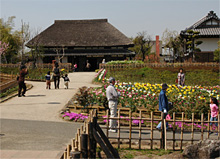
Here are about 300 cherry trees as well as a giant flower bed by the river Arakawa River which is full of tulips of all colors.
<Shobu-numa Park>
Summer flowers / hanashobu (Japanese iris)
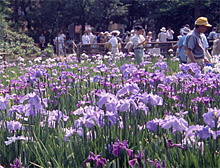
Summer is the season when greenery comes alive under the bright shining sun. In early summer, about 80 varieties of hanashobu, mostly the edo variety, totalling 6500 blossoms in all, can be enjoyed at the iris garden.
<Hanahata Memorial Park・Ouka-tei>
Autumn flowers / maple, keyaki (zelkova serrata)
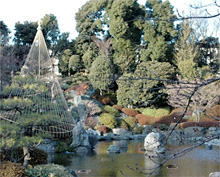
The black pines in the garden will be full of Japanese atmosphere, the sound of a waterfall can be heard. The autumn foliage colours the park in red and yellow shades. Once the leaves are gone, it is time to prepare for winter. be trussed with yukitsuri, or poles with ropes attached to it to protect trees from heavy snow.
In the Japanese-style pavillion Ouka-tei which looks out on to the garden, tea ceremonies may be held.
< Ooyata Park>
Winter flowers / plum
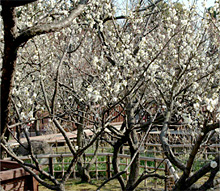
The plum garden has an azumaya (gazebo) as well as a mokudo (path with wood planks) There are about 170 plum trees in all, of which 120 are in the plum gardern. so you may enjoy the flowering trees at your leisure.




